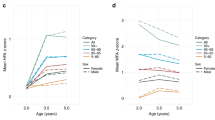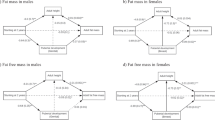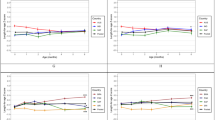Abstract
Introduction:
This study aims to evaluate a potential selection effect caused by exclusion of children with non-identifiable infancy peak (IP) and adiposity rebound (AR) when estimating associations between age and body mass index (BMI) at IP and AR and later weight status.
Subjects and methods:
In 4744 children with at least 4 repeated measurements of height and weight in the age interval from 0 to 8 years (37 998 measurements) participating in the IDEFICS (Identification and Prevention of Dietary- and Lifestyle-Induced Health Effects in Children and Infants)/I.Family cohort study, fractional polynomial multilevel models were used to derive individual BMI trajectories. Based on these trajectories, age and BMI at IP and AR, BMI values and growth velocities at selected ages as well as the area under the BMI curve were estimated. The BMI growth measures were standardized and related to later BMI z-scores (mean age at outcome assessment: 9.2 years).
Results:
Age and BMI at IP and AR were not identifiable in 5.4% and 7.8% of the children, respectively. These groups of children showed a significantly higher BMI growth during infancy and childhood. In the remaining sample, BMI at IP correlated almost perfectly (r⩾0.99) with BMI at ages 0.5, 1 and 1.5 years, whereas BMI at AR correlated perfectly with BMI at ages 4–6 years (r⩾0.98). In the total study group, BMI values in infancy and childhood were positively associated with later BMI z-scores where associations increased with age. Associations between BMI velocities and later BMI z-scores were largest at ages 5 and 6 years. Results differed for children with non-identifiable IP and AR, demonstrating a selection effect.
Conclusions:
IP and AR may not be estimable in children with higher-than-average BMI growth. Excluding these children from analyses may result in a selection bias that distorts effect estimates. BMI values at ages 1 and 5 years might be more appropriate to use as predictors for later weight status instead.
This is a preview of subscription content, access via your institution
Access options
Subscribe to this journal
Receive 12 print issues and online access
$259.00 per year
only $21.58 per issue
Buy this article
- Purchase on Springer Link
- Instant access to full article PDF
Prices may be subject to local taxes which are calculated during checkout


Similar content being viewed by others
References
Anderson PM, Butcher KE . Childhood obesity: trends and potential causes. Future Child 2006; 16: 19–45.
Sabin MA, Kao KT, Juonala M, Baur LA, Wake M . Viewpoint article: childhood obesity—looking back over 50 years to begin to look forward. J Paediatr Child Health 2015; 51: 82–86.
Baird J, Fisher D, Lucas P, Kleijnen J, Roberts H, Law C . Being big or growing fast: systematic review of size and growth in infancy and later obesity. BMJ 2005; 331: 929.
Bammann K, Peplies J, De Henauw S, Hunsberger M, Molnar D, Moreno LA et al. Early life course risk factors for childhood obesity: the IDEFICS case-control study. PLoS One 2014; 9: e86914.
Claris O, Beltrand J, Levy-Marchal C . Consequences of intrauterine growth and early neonatal catch-up growth. Semin Perinatol 2010; 34: 207–210.
Gardner DS, Hosking J, Metcalf BS, Jeffery AN, Voss LD, Wilkin TJ . Contribution of early weight gain to childhood overweight and metabolic health: a longitudinal study (EarlyBird 36). Pediatrics 2009; 123: e67–e73.
Giles LC, Whitrow MJ, Davies MJ, Davies CE, Rumbold AR, Moore VM . Growth trajectories in early childhood, their relationship with antenatal and postnatal factors, and development of obesity by age 9 years: results from an Australian birth cohort study. Int J Obes (Lond) 2015; 39: 1049–1056.
Giles LC, Whitrow MJ, Rumbold AR, Davies CE, de Stavola B, Pitcher JB et al. Growth in early life and the development of obesity by age 9 years: are there critical periods and a role for an early life stressor? Int J Obes (Lond) 2013; 37: 513–519.
Jones-Smith JC, Fernald LC, Neufeld LM . Birth size and accelerated growth during infancy are associated with increased odds of childhood overweight in Mexican children. J Am Diet Assoc 2007; 107: 2061–2069.
Jones-Smith JC, Neufeld LM, Laraia B, Ramakrishnan U, Garcia-Guerra A, Fernald LC . Early life growth trajectories and future risk for overweight. Nutr Diabetes 2013; 3: e60.
Monteiro PO, Victora CG . Rapid growth in infancy and childhood and obesity in later life—a systematic review. Obes Rev 2005; 6: 143–154.
Chivers P, Hands B, Parker H, Bulsara M, Beilin LJ, Kendall GE et al. Body mass index, adiposity rebound and early feeding in a longitudinal cohort (Raine Study). Int J Obes (Lond) 2010; 34: 1169–1176.
Cole TJ . Children grow and horses race: is the adiposity rebound a critical period for later obesity? BMC Pediatr 2004; 4: 6.
Gonzalez L, Corvalan C, Pereira A, Kain J, Garmendia ML, Uauy R . Early adiposity rebound is associated with metabolic risk in 7-year-old children. Int J Obes (Lond) 2014; 38: 1299–1304.
Hof MH, Vrijkotte TG, de Hoog ML, van Eijsden M, Zwinderman AH . Association between infancy BMI peak and body composition and blood pressure at age 5-6 years. PLoS One 2013; 8: e80517.
Rolland-Cachera MF, Deheeger M, Bellisle F, Sempe M, Guilloud-Bataille M, Patois E . Adiposity rebound in children: a simple indicator for predicting obesity. Am J Clin Nutr 1984; 39: 129–135.
Rolland-Cachera MF, Deheeger M, Maillot M, Bellisle F . Early adiposity rebound: causes and consequences for obesity in children and adults. Int J Obes (Lond) 2006; 30 (Suppl 4): S11–S17.
Silverwood RJ, De Stavola BL, Cole TJ, Leon DA . BMI peak in infancy as a predictor for later BMI in the Uppsala Family Study. Int J Obes (Lond) 2009; 33: 929–937.
Whitaker RC, Pepe MS, Wright JA, Seidel KD, Dietz WH . Early adiposity rebound and the risk of adult obesity. Pediatrics 1998; 101: E5.
Dietz WH . ‘Adiposity rebound’: reality or epiphenomenon? Lancet 2000; 356: 2027–2028.
Singhal A, Lucas A . Early origins of cardiovascular disease: is there a unifying hypothesis? Lancet 2004; 363: 1642–1645.
Ong KK, Ahmed ML, Emmett PM, Preece MA, Dunger DB . Association between postnatal catch-up growth and obesity in childhood: prospective cohort study. BMJ 2000; 320: 967–971.
Remacle C, Bieswal F, Reusens B . Programming of obesity and cardiovascular disease. Int J Obes Relat Metab Disord 2004; 28 (Suppl 3): S46–S53.
Martin-Gronert MS, Ozanne SE . Early life programming of obesity. Med Wieku Rozwoj 2013; 17: 7–12.
Kroke A, Hahn S, Buyken AE, Liese AD . A comparative evaluation of two different approaches to estimating age at adiposity rebound. Int J Obes (Lond) 2006; 30: 261–266.
Wen X, Kleinman K, Gillman MW, Rifas-Shiman SL, Taveras EM . Childhood body mass index trajectories: modeling, characterizing, pairwise correlations and socio-demographic predictors of trajectory characteristics. BMC Med Res Methodol 2012; 12: 38.
Tilling K, Macdonald-Wallis C, Lawlor DA, Hughes RA, Howe LD . Modelling childhood growth using fractional polynomials and linear splines. Ann Nutr Metab 2014; 65: 129–138.
Johnson W, Balakrishna N, Griffiths PL . Modeling physical growth using mixed effects models. Am J Phys Anthropol 2013; 150: 58–67.
Ahrens W, Bammann K, De Henauw S, Halford J, Palou A, Pigeot I et al. Understanding and preventing childhood obesity and related disorders—IDEFICS: a European multilevel epidemiological approach. Nutr Metab Cardiovas Dis 2006; 16: 302–308.
Ahrens W, Bammann K, Siani A, Buchecker K, De Henauw S, Iacoviello L et al. The IDEFICS cohort: design, characteristics and participation in the baseline survey. Int J Obes (Lond) 2011; 35 (Suppl 1): S3–S15.
Ahrens W, Siani A, Adan R, De Henauw S, Eiben G, Gwozdz W et al. Cohort profile: the transition from childhood to adolescence in European children—how I.Family extends the IDEFICS cohort. Int J Epidemiol 2016. (in press).
Cole TJ, Lobstein T . Extended international (IOTF) body mass index cut-offs for thinness, overweight and obesity. Pediatr Obes 2012; 7: 284–294.
Herrmann D, Suling M, Reisch L, Siani A, De Bourdeaudhuij I, Maes L et al. Repeatability of maternal report on prenatal, perinatal and early postnatal factors: findings from the IDEFICS parental questionnaire. Int J Obes (Lond) 2011; 35 (Suppl 1): S52–S60.
Börnhorst C, Siani A, Russo P, Kourides Y, Sion I, Molnár D et al. Early life factors and inter-country heterogeneity in BMI growth trajectories of European children: The IDEFICS Study. PLoS One 2016; 11: e0149268.
Macdonald-Wallis C, Tilling K, Fraser A, Nelson SM, Lawlor DA . Associations of blood pressure change in pregnancy with fetal growth and gestational age at delivery: findings from a prospective cohort. Hypertension 2014; 64: 36–44.
Williams S, Davie G, Lam F . Predicting BMI in young adults from childhood data using two approaches to modelling adiposity rebound. Int J Obes Relat Metab Disord 1999; 23: 348–354.
Freedman DS, Kettel Khan L, Serdula MK, Srinivasan SR, Berenson GS . BMI rebound, childhood height and obesity among adults: the Bogalusa Heart Study. Int J Obes Relat Metab Disord 2001; 25: 543–549.
Dietz WH . Critical periods in childhood for the development of obesity. Am J Clin Nutr 1994; 59: 955–959.
Sigmund E, Sigmundova D, El Ansari W . Changes in physical activity in pre-schoolers and first-grade children: longitudinal study in the Czech Republic. Child Care Health Dev 2009; 35: 376–382.
Taylor RW, Williams SM, Farmer VL, Taylor BJ . Changes in physical activity over time in young children: a longitudinal study using accelerometers. PLoS One 2013; 8: e81567.
Ben-Shlomo Y, Kuh D . A life course approach to chronic disease epidemiology: conceptual models, empirical challenges and interdisciplinary perspectives. Int J Epidemiol 2002; 31: 285–293.
Kuh D, Ben-Shlomo Y, Lynch J, Hallqvist J, Power C . Life course epidemiology. J Epidemiol Community Health 2003; 57: 778–783.
Tu YK, Tilling K, Sterne JA, Gilthorpe MS . A critical evaluation of statistical approaches to examining the role of growth trajectories in the developmental origins of health and disease. Int J Epidemiol 2013; 42: 1327–1339.
Sayers A, Heron J, Smith A, Macdonald-Wallis C, Gilthorpe M, Steele F et al. Joint modelling compared with two stage methods for analysing longitudinal data and prospective outcomes: a simulation study of childhood growth and BP. Stat Methods Med Res 2014. e-pub ahead of print 11 September 2014 doi:10.1177/0962280214548822.
Acknowledgements
This work was carried out as part of the IDEFICS study (http://www.idefics.eu) and the I.Family Study (http://www.ifamilystudy.eu/). We thank the financial support of the European Community within the Sixth RTD Framework Programme Contract No. 016181 (FOOD) for the IDEFICS study and within the Seventh RTD Framework Programme Contract No. 266044 for the I. Family study.
Author contributions
Each author has seen and approved the contents of the submitted manuscript. All authors contributed to conception and design, acquisition of data, analysis or interpretation of data. Final approval of the version published was given by all the authors. All the authors revised the article critically for important intellectual content.
Author information
Authors and Affiliations
Consortia
Corresponding author
Ethics declarations
Competing interests
The authors declare no conflict of interest.
Additional information
Supplementary Information accompanies this paper on International Journal of Obesity website
Supplementary information
Rights and permissions
About this article
Cite this article
Börnhorst, C., Siani, A., Tornaritis, M. et al. Potential selection effects when estimating associations between the infancy peak or adiposity rebound and later body mass index in children. Int J Obes 41, 518–526 (2017). https://doi.org/10.1038/ijo.2016.218
Received:
Revised:
Accepted:
Published:
Issue Date:
DOI: https://doi.org/10.1038/ijo.2016.218
This article is cited by
-
Longitudinal association between the timing of adiposity peak and rebound and overweight at seven years of age
BMC Pediatrics (2022)
-
Age at adiposity rebound and the relevance for obesity: a systematic review and meta-analysis
International Journal of Obesity (2022)
-
Associations of grandparental diabetes mellitus with grandchild BMI status
BMC Public Health (2019)



